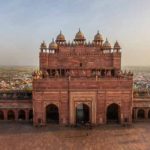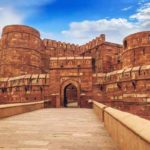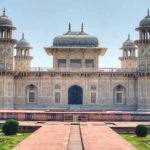Agra Red Fort

A stunning set of monuments, the Agra Fort or the Agra Red Fort is a World Heritage Site. The majestic fort is located in the beautiful Indian city of Agra in Uttar Pradesh.
Agra is home to many architectural marvels of the Mughal Empire and boasts of two more World Heritage Sites including the Taj Mahal and Fatehpur Sikri.
Known to many as Red Fort of Agra or Fort Rouge owing to the lavish use of red sandstone, the enclosure houses several sites and structures that display royal Mughal architectural heritage and splendor. Some of the exquisite structures that deserve a mention are:
Sheesh Mahal – Literally meaning ‘Glass Palace‘ it was the royal dressing room adorned by tiny mirror-like glass-mosaic decorations on the walls.
The Diwan-i-Am – Which was used as a communications ground between the public and the aristocracy and once housed the Peacock Throne.
Diwan-i-Khas – A hall of private audience, it was used to welcome kings and dignitaries.
The Anguri Bagh – It houses 85 square, geometrically arranged lush gardens.
Khas Mahal – An immaculate white marble palace.
Mina Masjid – Literally meaning ‘Heavenly Mosque’ it is a tiny mosque closed to the public.
Nagina Masjid – Literally meaning ‘Gem Mosque’ it was designed exclusively for the ladies of the court.
Musamman Burj – A large, octagonal tower with a balcony facing the Taj Mahal.
By far, the most important fort of India, the Agra Fort is a treat for sore eyes and a thrill to weary senses.
Mehtab Bagh Agra

The Mehtab Bagh in Agra is laid out in just right symmetry and alignment with the Taj Mahal and it was intentionally built as an integral part of the original design of the Taj Mahal during the period from 1631 to 1635 A.D. It has been named as the ‘Mehtab Bagh‘ or ‘The Moon Garden’ because it is an ideal point for viewing the Taj Mahal in romantic moonlight.
History of Mehtab Bagh,Agra
When the world famous Taj Mahal was being constructed 350 years ago a moonlight garden named Mehtab Bagh was laid just across the Yamuna River. It was laid alongside the northern waterfront. The place was once an oasis with sweet-smelling flowers, shaded pavilions, fountain jets and reflecting pools but it ceased to exist in the due course of history. Gradually the site became barren and lost its earlier charm. Once you visit the Mehtab Bagh in Agra you will get transformed into the glorious Mughal era. This is one of the most famous gardens in Agra.
Description of Mehtab Bagh,Agra
Agra Mehtab Bagh is a 25-acre plot has now transformed into an epicenter for the top court-ordered project to set up protective greenways around the Taj. As the land is reclaimed, historians and geographers from around the world are trying to learn about the wonderful garden that once existed near this oasis. An advance technology inspired from Iran has been applied to bloom the Mehtab Bagh once again. Mehtab Bagh in Agra will again flower with fragrant and colorful flowers which will surely produce the sweet smell of the glorious past.
The growing attention to Agra Mehtab Bagh can be credited to the escalating concern for the Taj and its grounds, which are in danger by urban sprawl, too many tourists, and air pollution that eats away into the shrine’s marble exterior. The lush gardens that once lined the riverbanks on either side of the Taj may flourish again in a scheme to protect it from further damages. Conservationists uphold that a buffer zone of greenery would keep development at bay and help remedy local air, noise, and water pollution. Much of the land for the greenbelt had already been acquired through a previous proposal to establish a 340-acre national park around the Taj. While yours to Agra a visit to this opulent garden will mark you treat your eyes far away from the hustle bustle of the busy town.
Taj Mahal Garden

Taj Mahal is the most important monument in Agra which is the symbol of eternal love. It features among the Seven Wonders of the World. Taj Mahal incorporates both Persian and Hindu elements; therefore Taj Mahal flaunts a Persian style garden. Garden in Persian culture is a very important motif as Quran equates a gorgeous garden with ecstasy. Stretched from the main gateway to the doorway of this mausoleum, the lush green Taj Mahal garden in Agra is based on symmetry and geometrical measurements.
Description of Taj Mahal Garden, Agra
Taj Mahal gardens, Agra mostly feature religious motifs. The Water Garden, for example, is divided into four equal squares by two marble canals. The garden is bounded by cypress trees and fountains; the garden conjures up the Islamic concept of heaven where rivers of water, milk, wine and honey flow. At the center of the garden and the mausoleum a lotus shaped tank is located. The water in the tank acts as a reflective facade and the image of Taj can be seen on the water from any spot in the garden. The exclusive location of the tank helps the mirror like viewing of this extravagant monument of love.
The Taj Mahal Garden in Agra features a Persian style garden which symbolizes heaven, since Quran describes paradise as a beautiful garden. On the other hand the water garden of the Agra Taj Mahal garden feature two marble canals with fountains and lined with cypress trees (symbolizing death).
This divides the garden into four identical squares (Islam recognizes four to be a holy number), the stone paved pathways again subdivides each flower bed into 4, making total of 16 flower beds.
The tank has been arranged to provide a crystal clear view of Taj in its water. The view looks wonderful with the reflection of Taj amidst the green cypress trees.
Taj Mahal Garden in Agra displays a unique irrigation system. Water in the canals was drawn from the river using purrs, a system of drawing water physically from river using bucket and ropes. For irrigation the water from the overflowing canals was used. The north-south canals had its water bay through fountains and east-west canal had its water bay through a intermingling with north-south canal. It has been made very uniquely which still astonishes the tourists who come here to view the eternal monument of love.
Taj Mahal Agra

The Taj Mahal is the epitome of Mughal art and one of the most famous buildings in the world. Yet there have been few serious studies of it and no full analysis of its architecture and meaning. Ebba Koch, an important scholar, has been permitted to take measurements of the complex and has been working on the palaces and gardens of Shah Jahan for thirty years and on the Taj Mahal itself—the tomb of the emperor’s wife, Mumtaz Mahal—for a decade.
The tomb is the representation of the house of the queen in Paradise, and its setting was based on the palace gardens of the great nobles that lined both sides of the river at Agra India. You will explore the entire complex of the Taj Mahal with an explanation of each building and an account of the mausoleum’s urban setting, its design and construction, its symbolic meaning, and its history up to the present day.
Jama Masjid

Jami Masjid, also known as Jama Masjid, is one of the largest and grandest building in Fatehpur Sikri.. The mosque is called Jama Masjid, which is a usual name throughout the Islamic world for the principal mosque of the town.
The word is derived from Arabic, when it literally means the Friday Mosque. The Arabic name for Friday is Day of Congregation and mosque means a place of prostration and hence the name. This mosque is a striking example of the blending of the Saracenic and Hindu styles of architecture. On account of its massive structure which is very impressive, it is regarded as one of the finest example of its kind in India. Though the shrine is richly ornamented and elaborately carved, yet it cannot compare with the delicacy of design of the Jama Masjid at Delhi.
In the centre is a paved open court for congregation. Cloisters surround it on three sides pierced by two gateways to east and south. The former was called King’s gateway as Emperor Akbar used to pass through this gate on his way from the royal palaces to the Jami Masjid and the latter is the famous Buland Darwaza or the Gate of Victory.
The shrine occupies the western end of the quadrangle and is crowned by three massive domes. The large halls on either side of the central chamber with majestic pillars of Hindu style and the entire western wall marked by arcaded arches richly ornamented make the place most imposing. When one enters into the domed prayer chamber, one sees that the external form of the building does full justice to its splendid interior. The extraordinary painting on the vast dome is a graceful example of Persian style.
There are three arches, which mark the Qibla, the direction of the Kaaba in the holy city of Mecca, to which all devout Muslims turn in prayer. In the direction of the central mihrab is located the pulpit, which is a simple marble structure of three steps. This is the place from where Khutba (Friday oration) used to be read in the name of the Mughal emperors, with prayers for their welfare. On important festivals, as per Muslim calendar Khutba used to be read in the name of the Emperor.
These subsidiary mihrabs follow the general design of the central ones but are quite differently decorated; in those nearest the centre the red sandstone is inlaid with glazed tiles of green and royal blue, turquoise and white; in the middle chambers with white marble framed in black, in the furthest entirely in white marble.
Moti Masjid Agra

There are many notable holy places in Agra of which Moti Masjid in Agra occupies special position of distinction. It is held that one who has visited the St. Basils Cathedral in Moscow will feel that it contains close structural resemblance with that. Sitting in the compound of the Agra Fort where river Yamuna is also present in the backdrop, this mosque is very frequently visited by the travelers. Its shiny domes are built with light white marble which lends it a very velvety look and adds a sparkle to its beauty.
History of Moti Masjid, Agra
The Agra Moti Masjid was built by the very powerful emperor and a connoisseur of art famously called Shah Jahan. During the rule of Shah Jahan the Mughal emperor, numerous architectural wonders were built. Today most of these are the feast for the eyes. However coming back to the Moti Masjid it can be said that Moti Masjid earned the epithet Pearl Mosque for it shined like a pearl. It is held that this mosque was constructed by Shah Jahan for his members of royal court.
Description of Moti Masjid, Agra
Moti Masjid in Agra is a delightful sight for eyes. Its architectural features are quite similar to that of the St. Basils Cathedral in Moscow. It is located in the vicinity of River Yamuna and enjoys its position in the compound of the invincible Agra Fort. It contains three domes built of light white marble. The three marble domes stand on the red sandstone walls. Looking at its structure you will come across the splendid symmetrical design of the mosque. Sitting to the right of the hall Diwan-E-Aam of the Agra Fort, the mosque mesmerizes travelers with its velvety appearance.
The Agra Moti Masjid is very close to the city center. Hence reaching this place is never a problem. To reach here you can avail the apt bus services from the Power House Bus Stand. The railway station is also very near to it. This apart, the Agra Airport is situated to the south-west of Agra Fort. To come here directly form the airport you need to cover a distance of 8 km.
Fatehpur Sikri

Fatehpur Sikri is a fascinating ghost city built in the 16th century; 37 km from Agra Akbar the great, who at 26 years did not have an heir, founded this historic site. Fatehpur Sikri He went to a saint, Shaikh Salim Chishti who lived in a city called Sikri. His blessing gave Akbar 3 sons. As a gesture, Akbar built a whole new city in Sikri. Akbar named his new capital Fatehpur Sikri or the City of Victory
Fatehpur Sikri is one of the finest examples of Mughal architectural splendour at its height. It was built between 1569 and 1585 and was intended to be the joint capital with Agra, but was soon deserted because the water system could not support any residents. It remained untouched for over 400 years now and its palaces are a remainder of the extravagance of the Mughals Fatehpur Sikri is the best example of the culmination of Hindu and Muslim architecture. Fatehpur Sikri Mosque is said to be a copy of the mosque in Mecca and has designs, derived from the Persian & Hindu architecture. After this within 20 years, the capital of Mughals was shifted to Lahore.
Baby Taj

Located in the same city as the Taj Mahal itself, the Baby Taj is a beautiful example of both the history and the architecture of the country. On the off time (for tourists) when I was in India, this was an amazing time to visit some of the smaller attractions in Agra like the Baby Taj. There is always people at the Taj itself but when I visited the Baby Taj it was almost completely empty and it was an overwhelming and beautiful experience.
Buland Darwaza

Buland Darwaza, the triumphal Gateway, was erected by Akbar in 1601 in commemoration of his victory over Khandesh and Ahmednagar in Southern India. Buland Darwaza is the greatest monumental structure of Akbar’s entire reign. Even now it has no parallel and is the largest, loftiest and most stately in the whole of India. In its own class, it is one of the greatest in the world. Here, marble and sandstone have been used in effective combination in its decoration, which only the masons of the Mughal period knew. The inlaid marble work in the arches and the Hindu style of architecture in the gallery above the entrance are worth a visit. The total height of the Gate above the pavement is 176 ft.
The great gate itself is quite plain. The three horizontal panels of buff stone noticeable in Badshahi Darwaza are also present here. The plain red sandstone spandrels are framed n white marble with a flower like ornament inlaid in white marble at the apex of the arch, and a flattish rosette, centered with the narrow panel above it, on either side. The cusped ornament, large and bold in fact, but small and delicate when seen from below, is carried down below the springing of the arch. Two pieces have been broken off from the left hand side and eight from the right.
Visitors to the Gate will find that up to several feet beyond human reach, the door is covered with horseshoes of other draft cattle. Popularly, they are believed to have been stuck on the Gate for luck by simple devoted peasants to seek the blessings, of Saint Sheikh Salim Chisti. The practice of a similar nature is still current, of tying threads or pieces of cloth to the screens in the Sheikh’s tomb for the fulfillment of vows particularly by barren women.
Passing through the central hall and admiring the fine proportion of the dome covering it, and the bold medallion painted in the centre, one emerges into the courtyard of the mosque, under the dome. Doorways open on either side onto the southern cloister.
Akbar’s Tomb

Situated at Sikandra, Akbar’s Tomb lies 4 km to the northeast of Agra. The architectural style of this tomb is unique that makes it worthy of witnessing. Quite different from almost all the other tombs of the Mughals, it is indeed mesmerizing and worthwhile. You can see a kind of fusion of different styles of architecture.
Plan a Trip to Jammu & Kashmir
wildlife viewing in National Park Ranthambore
Book Rajasthan Best Tour Packages








